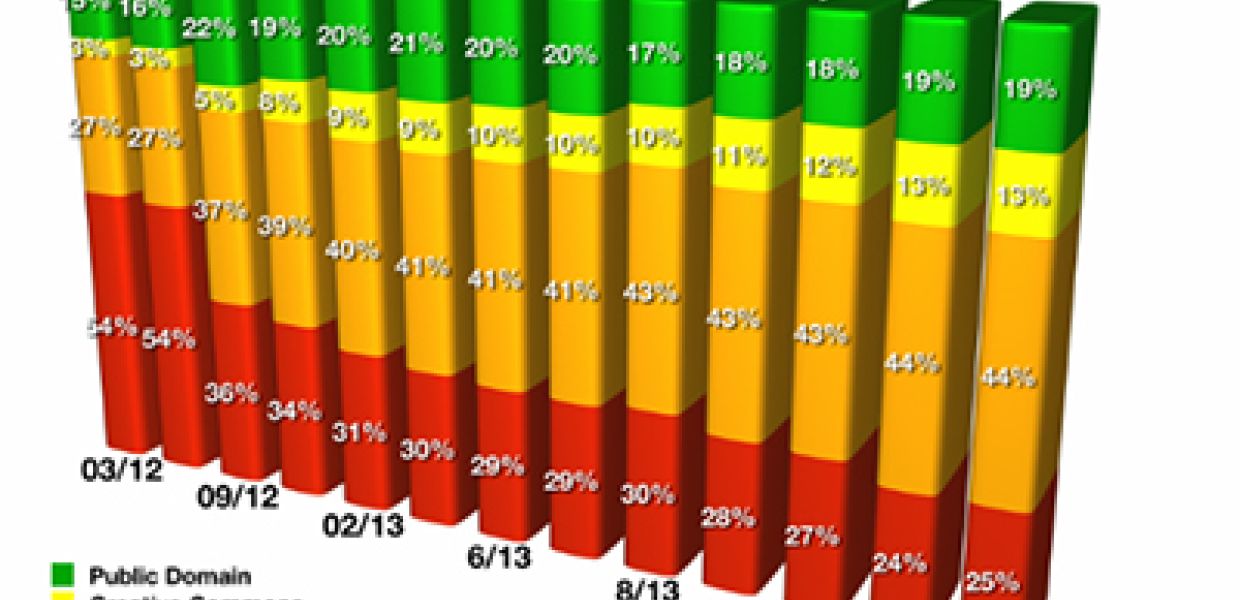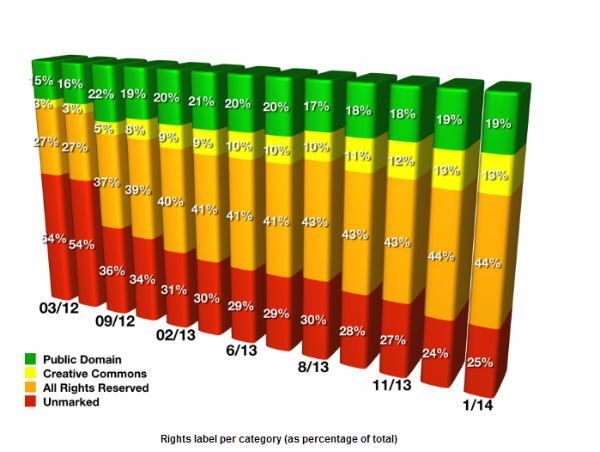Europeana digital objects to have valid rights statement by July 2014

- Title:
- Creator:
- Europeana
- Copyright:
- CC BY-SA
Throughout 2013, we spent a fair amount of time looking at how to improve the quality and presence of rights statements. While this process has led to a significant reduction of the share of digital objects without a rights statements, we have not yet achieved our objective to have all digital objects available via Europeana carry a rights label. In addition, we have undertaken a review of the Europeana Licensing Framework. Part of the outcomes of this review are a small number of changes to the rights statements that are available, such as the introduction of a new rights statement for Orphan Works. This blog post explains the progress made in the past year, how we plan to deal with the remaining legacy of unlabelled objects, the changes to the existing rights statements and what all of this will mean in practice.
Progress made with rights statements, more work to be done
The rights statement associated with each digital object available via Europeana indicates to the end-user how a digital object can be accessed and re-used. Their quality and presence form an important part of making high quality, relevant content available via Europeana. They allow end-users and users of the Europeana API to clearly identify which digital objects can be re-used under which conditions, but they also clearly signal which works may not be re-used without asking for permission from copyright holders. Given the importance of this, it is essential that they are applied consistently across datasets ingested into Europeana.
In 2013 Europeana, together with Kennisland, set out on an extensive Rights Labelling Campaign to ensure that digital objects available via Europeana are labelled with correct rights statements. With the help of our partners, we managed to increase the number of digital objects that can be re-used (an increase of 3.2 million since december 2012), and to reduce the percentage of unlabelled objects (a reduction from 34% to 25% of the total since December 2012). However, our work is not completed in this regard, and we are making a concerted effort to have all digital objects available via Europeana labelled with a valid rights statement by July 2014.

Image credit: CC-BY-SAKennisland
Resolving the unlabelled legacy in the Europeana Portal.
Having rights labels for all digital objects is an essential step towards stimulating re-use of the material available via Europeana. Without a rights label attached to it, end-users and API users have no information on whether a digital object can be used or not. To meet our target of having all objects labelled with rights statements by July 2014, we will be approaching partners via their aggregators/projects with options regarding unlabelled collections. If you are a data provider and you have digital objects that do not currently have rights statements attached, please contact [email protected], and we will assist you in this transition. Alternatively, Europeana’s aggregation team will contact you shortly to help you with your options, which may include the temporary removal of digital objects while you decide on the correct rights statement.
Improving the rights statements
One of the things we learnt over the last two years is that we need to make choosing an appropriate right statement easier for aggregators and data providers, and easier for the end-user to understand. A review of the Europeana Licensing Framework undertaken during the summer of 2013 recommended a number of changes to the rights statements currently available to express the copyright status of digital objects available via Europeana. These recommendations include the addition of two new rights statements, the removal of one existing rights statement and small adjustments to three others. We believe that these changes, outlined below, ensure that the rights statements are better suited to the needs of our partners, and easier to understand for the users of Europeana.
Two new rights statements
Effective today we have added two new rights statements to the list of available rights statements that can be used with edm:rights:
- The Orphan Works statement is intended for use with digital objects where the copyright holder cannot be identified after a diligent search in accordance with the rules established by the EU directive on certain permitted uses of Orphan Works. Data providers should be aware that the directive has not been implemented in all member states yet and that it does not apply to all types of works (most notably it does not apply to standalone photography). The rights statement informs users of the Orphan Works status of the digital object and that they are free to carry out any of the acts permitted by their national copyright and related rights act, including browsing, printing and making copies for their own personal purposes.
- The Out of copyright - non commercial reuse statement is intended for use with public domain works that were digitised as part of a public-private partnership. It may only be applied where the conditions of the agreement of the public/private partnership limit the commercial use of the digital object by the public. The rights statement acknowledges that the work is out of copyright and stipulates that the digital object may not be used for commercial purposes by third parties.
Updated rights statements
Effective today we have also made small changes to three of the existing rights statements:
- Following the introduction of the Orphan Works rights statement, it was necessary to update the wording for the Unknown rights statement to avoid confusion between the two. Europeana will contact partners via their aggregators/projects who have submitted material using the previous Unknown rights statement to ensure this is the appropriate rights statement for the collection.
- Rights Reserved - Free Access has been renamed ‘Free Access - No Re-use’ to emphasise the fact that end-users may freely access the associated digital objects but that they do not have permission to re-use them for anything other than personal use.
- Rights Reserved - Paid Access has been renamed ‘Paid Access - No Re-use’ to highlight the fact that the end-user must pay for access to the digital object, which may only be used personally.
Removing the Rights Reserved - Restricted Access statement
The Rights Reserved Restricted Access will be retired in mid-2014 (since December 2013 we have stopped accepting new digital objects with this statement). The review of the licensing framework had concluded that only a small fraction of all digital objects carrying this rights statement were in fact restricted access and that as a result, this rights statement should not be offered anymore. Partners who have previously submitted material with this statement will be contacted via their aggregators/projects in order to choose new rights statements.
We hope that by implementing these changes regarding rights statements, it will be easier for partners to select the correct rights statement for their digital objects, and for end-users to make the most of the wonderful collections and objects available via Europeana. If you have any questions on this matter or want further information about Europeana’s rights statements, please check here or contact [email protected].
